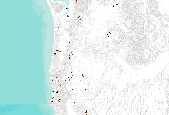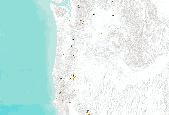|
|

The Institute for Bird Populations (IBP) coordinates the Monitoring Avian Productivity and Survivorship (MAPS) Program to assess and monitor the vital rates and population dynamics of North American landbirds. The MAPS Program utilizes a standardized constant-effort mist netting and banding protocol (DeSante et al. 2010) at a continent-wide network of monitoring stations. Each summer dedicated volunteers operate bird-banding stations to collect data on individual "birds-in-the-hand" representing over 200 species. Analyses of MAPS data provide critical information relating to the ecology, conservation, and management of North American landbird populations and the factors responsible for changes in their populations....

The Institute for Bird Populations (IBP) coordinates the Monitoring Avian Productivity and Survivorship (MAPS) Program to assess and monitor the vital rates and population dynamics of North American landbirds. The MAPS Program utilizes a standardized constant-effort mist netting and banding protocol (DeSante et al. 2010) at a continent-wide network of monitoring stations. Each summer dedicated volunteers operate bird-banding stations to collect data on individual "birds-in-the-hand" representing over 200 species. Analyses of MAPS data provide critical information relating to the ecology, conservation, and management of North American landbird populations and the factors responsible for changes in their populations....

These data identify, in general, the areas of FINAL critical habitat for Empidonax traillii extimus (southwestern willow flycatcher).

The Institute for Bird Populations (IBP) coordinates the Monitoring Avian Productivity and Survivorship (MAPS) Program to assess and monitor the vital rates and population dynamics of North American landbirds. The MAPS Program utilizes a standardized constant-effort mist netting and banding protocol (DeSante et al. 2010) at a continent-wide network of monitoring stations. Each summer dedicated volunteers operate bird-banding stations to collect data on individual "birds-in-the-hand" representing over 200 species. Analyses of MAPS data provide critical information relating to the ecology, conservation, and management of North American landbird populations and the factors responsible for changes in their populations....

The Institute for Bird Populations (IBP) coordinates the Monitoring Avian Productivity and Survivorship (MAPS) Program to assess and monitor the vital rates and population dynamics of North American landbirds. The MAPS Program utilizes a standardized constant-effort mist netting and banding protocol (DeSante et al. 2010) at a continent-wide network of monitoring stations. Each summer dedicated volunteers operate bird-banding stations to collect data on individual "birds-in-the-hand" representing over 200 species. Analyses of MAPS data provide critical information relating to the ecology, conservation, and management of North American landbird populations and the factors responsible for changes in their populations....

This dataset represents bald eagle locations compiled for the United States Bureau of Land Management's Western Oregon Plan Revision. Included is forest type found at each site.

These data are expert model outputs for Bird: Arizona Bell's vireo - Vireo bellii arizonae (Primary, Breeding, Foraging) species distribution, completed by Dudek and ICF International.  Development of the species habitat models was a multi-step process involving a collaboration of biologists and GIS analysts. To facilitate this collaboration and to document the process, a DRECP species modeling Microsoft SharePoint site was created. The SharePoint site allowed biologists to select and parameterize the data layers considered important for the habitat model of each species. The selection and parameterization of the model for each species was based on the best available scientific information related to the speciesâ...

This dataset depicts pheasant habitat in Montana.

Display of gray partridge distribution in Montana (USA). Distribution was originally mapped in 1970 by Montana Fish, Wildlife and Parks (MFWP) wildlife biologists and later digitized.

Other areas of natural resource significance may be documented, depending on the type and extent of resources in the mapped area. These additional areas are not publicly managed nor do they have any special designation, but they have been identified as special places meriting spill protection. These resource areas are mapped because they are valued for natural qualities, such as habitats supporting large numbers of non-listed species. Examples include migratory waterfowl resting areas, important fishery areas, and natural communities. These areas are uniquely vulnerable to oil spills. Therefore, this coverage helps to bring such areas of the Lake Michigan Basin to the attention of spill planners and responders....

Display of Ruffed Grouse distribution in Montana (USA). Distribution was originally mapped in 1970 by Montana Fish, Wildlife and Parks (MFWP) wildlife biologists and later digitized.

The Institute for Bird Populations (IBP) coordinates the Monitoring Avian Productivity and Survivorship (MAPS) Program to assess and monitor the vital rates and population dynamics of North American landbirds. The MAPS Program utilizes a standardized constant-effort mist netting and banding protocol (DeSante et al. 2010) at a continent-wide network of monitoring stations. Each summer dedicated volunteers operate bird-banding stations to collect data on individual "birds-in-the-hand" representing over 200 species. Analyses of MAPS data provide critical information relating to the ecology, conservation, and management of North American landbird populations and the factors responsible for changes in their populations....

The objective of this project was to digitally map the boundaries of Audubon California's Important Bird Areas (IBA). Existing Important Bird Areas identify critical terrestrial and inland water habitats for avifauna, in particular, habitat that supports rare, threatened or endangered birds and/or exceptionally large congregations of shorebirds and/or waterfowl. The digitization of Important Bird Areas represents an important first step in conservation planning of these critical habitats using GIS. As of October 2007, a draft layer of all 148 Important Bird Areas in California was completed. Currently, a review is in progress with Audubon Chapters and local experts, with a final version completed by Nov. 1, 2008....

This is a polygon buffer, surrounding the US Fish and Wildlife Service region 3 (http://www.fws.gov/midwest/endangered/).

Display of Spruce Grouse distribution in Montana (USA). Distribution was originally mapped in 1970 by Montana Fish, Wildlife and Parks (MFWP) wildlife biologists and later digitized.

This data set contains sensitive biological resource data for bald eagle, great blue heron, and seabird nesting sites in Puget Sound and Strait of Juan de Fuca, Washington. Vector points in this data set represent the locations of bird nesting sites. Species-specific abundance, seasonality, status, life history, and source information are stored in relational data tables designed to be used in conjunction with this spatial data layer. This data set comprises a portion of the Environmental Sensitivity Index (ESI) data for Puget Sound and Strait of Juan de Fuca. ESI data characterize the marine and coastal environments and wildlife by their sensitivity to spilled oil. The ESI data include information for three main...

Display of Sharptail Grouse distribution in Montana (USA). Distribution was originally mapped in 1970 by Montana Fish, Wildlife and Parks (MFWP) wildlife biologists and later digitized.

Display of Blue Grouse distribution in Montana (USA). Distribution was originally mapped in 1970 by Montana Fish, Wildlife and Parks (MFWP) wildlife biologists and later digitized.
|
|